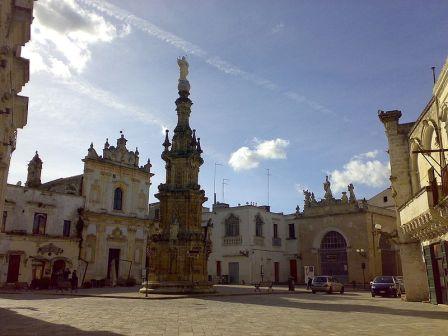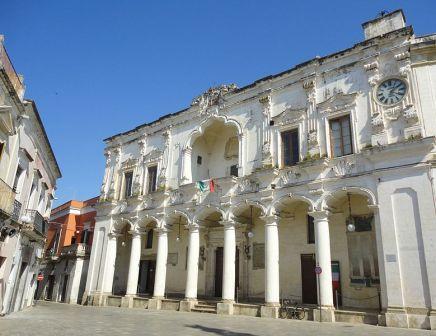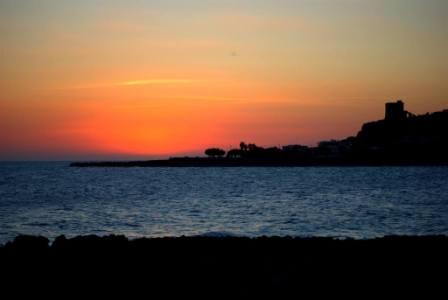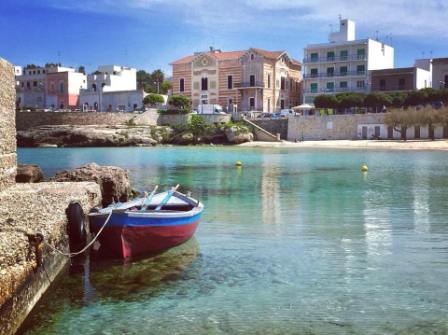Nardò and his Marines
Nardò
Nardò is a town south-east of Lecce of about 40,000 inhabitants. It is rich in history, monuments and squares, however it is located a few kilometers from the sea and is lined with small marinas, one more beautiful than the other.
The origins of Nardò date back to around the VIII-III century BC when it was a center of the ancient Messapi civilization. The city took the name of Nerito (from the ancient Greek nar, meaning water), then under the Romans it became Neretum and was elected a seaside resort because of the Emporium Naunia (which was at today's S. Maria al Bagno), finally it became the current Nardò. In 269 BC, the town was conquered by the Romans and crossed by the famous Via Traiana, which ran along the entire Ionian coast.
After the Roman fall, Nardò passed under the dominion of the Byzantines from the 6th to the 11th century and this led to the presence of the Basilian monks, who spread a new type of construction in caves. The Normans took possession of the city in 1055 and from 1266 the Angevins took over and developed feudalism. However, the influences of Byzantine culture remained much longer, so much so that the Greek language and liturgy persisted over the centuries until 1577, when by order of the Council of Trent the Greek rite was definitively suppressed. In 1497 the fief of Nardò was assigned to Andrea Matteo Acquaviva, whose son, Belisario, became its duke. The figure of Belisario is famous, he was a humanist and patron of the city, thus starting the long possession of the Acquaviva family which lasted until the beginning of the century. XIX when feudalism was dismissed and which also saw very bloody moments such as during the seventeenth century when Gerolamo Acquaviva sowed terror by murdering Baron Pietro Sambiasi and six priests of the cathedral following an attempt at a pro-French revolt of the Neretines, but in fact ensuring Nardò to the Acquaviva still lived for several centuries.
What see
The answer to the question what to see in Nardò could be taken for granted: the marinas. But that's not all, we can assure you: in Nardò there is much more.
Let's start with recommending the Cathedral Basilica of Santa Maria Assunta, created to replace the historic church of Santa Maria di Nerito. It is a basilica, very classic in its architecture which, however, preserves various prestigious frescoes and the Crucifix, which was built in the thirteenth century, which has the peculiarity of being made with black cedar wood.
Another noteworthy church is that of San Domenico, which dates back to 1500. The Church of the Immaculate Conception, which is considered one of the masterpieces of Lecce stone. Finally, there are the Church of Santa Chiara, the Church of the Blessed Virgin Mary of Carmel, the Church of Santa Maria della Purità, the Church of San Trifone, the Church of Sant'Antonio da Padova, the Church of Santa Teresa
and the Crypt of Sant'Antonio Abate, where you can see many Byzantine style frescoes.
In neoclassical style, however, it is the Episcopal Seminary. Taking another tour of the city and going beyond what are the religious architectures, in Nardò one cannot fail to visit the University building, or Palazzo di Città, created to house the Mayor of the Nobles and the Mayor of the People in the 16th century. It should be noted that this structure was also the seat of the Court of Lecce. But that's not all, because there are also the seat, the Acquaviva Castle, in addition to the various Coastal Towers
and to the fortified farms.
Le Marine di Nardò, four gems set on a coast of extraordinary beauty.
The marinas of Nardò are located on the Ionian side of Salento and are characterized by a landscape that is sometimes rocky and sometimes sandy, a bit like the whole Salento peninsula. Each of the marinas has characteristics that make it unique, particular and different from the others.
Sant'Isidoro
We will start this ideal journey to discover the marinas of Nardò starting from Sant'Isidoro, a town that is acquiring its own identity and that in the past was known more than anything else for its proximity to Porto Cesareo and as a fish market. Today, however, Sant'Isidoro is exploding, also because the beauty that characterizes it, and which is enclosed in the sea and in the golden beach, is increasingly valued, with works of different kinds. The hamlet takes its name from the tower that is located on its territory and which stands on the sandy coast, as if to protect it. The Tower of Sant'Isidoro dates back to the 16th century and was built by Charles V precisely in order to defend the area of Nardò from the Saracens. It is a very simple tower in its architecture, but also very impressive and suggestive to see, which now appears to be a summer residence for private individuals.
Porto Selvaggio
We arrive in the paradisiacal Porto Selvaggio, which is, with good reason, one of the most loved pearls of Salento and which makes the whole side shine with its beauty and its wild character that makes it different from all the rest of the surrounding places. What characterizes it is the combination of sea, beach, cliff, pine forest, as well as the so-called Mediterranean scrub, which is configured as something rare and, therefore, to be safeguarded. Here there are two towers, Torre Uluzzo and Torre Inserraglio, which, unfortunately, are not in optimal conditions like the other towers located in the municipality of Nardò. Since 2007 this marina has been included by the FAI among the 100 places of the heart that must be saved and this is because it contains species in danger of extinction as regards the flora. The aforementioned park falls entirely within the municipality of Nardò which, therefore, not only owns it but also manages it. Porto Selvaggio is, from a landscape point of view, one of the most beautiful areas of Salento and is frequented by people and tourists from all over Italy and the world.
The southern border of Porto Selvaggio coincides with the town of Santa Caterina and with the Alto promontory.
Saint Catherine
Moving, then, we find Santa Caterina ideal destination for those who want a holiday of sea, sun and relaxation and fun. Here there are many clubs, restaurants, meeting places and everything a tourist could want. The area is also well known for some beautiful stately villas which are the symbol of the rich bourgeoisie that previously populated the area. One of the characteristics of Santa Caterina is the coast, where you can see an alternation of sand and cliffs, which make it unique. In the area there are two coastal towers, namely Torre Santa Caterina and Torre dell'Alto, also built in the same century and with the same purposes. All these towers, in fact, are part of a larger control system and are communicating with each other.
Santa Maria al Bagno
The last marina in the municipality of Nardò is Santa Maria al Bagno. The marina dates back to the prehistoric era and several testimonies have been found to confirm this. The development of the city as it is today, however, is much more recent, as it has become a spa of strategic importance only under Roman rule. The fact that it is a spa town also explains the words “al bagno” which many find curious. Here too there is a coastal tower, known as the Tower of the Galatena River (of which the four corner bastions represent what remains) born in the same period as the other and, of course, with the same purpose.
Above there is only a small description of the marinas of Nardò, to see all the photos and discover everything that a marina hides both as a seascape and as a history click below on the name of the marina of your interest.











